Notre Dame and North Carolina matched up extremely evenly in explosiveness and efficiency in a defense-optional battle. Still, the Irish created just enough advantages on the margins, like converting scoring chances and field position to pull away. Breaking down the ND defensive performance and if Marcus Freeman is still within the return policy window, how limiting havoc has enabled the Irish offense to sustain long drives and a key ingredient in the season-long trend of winning close.
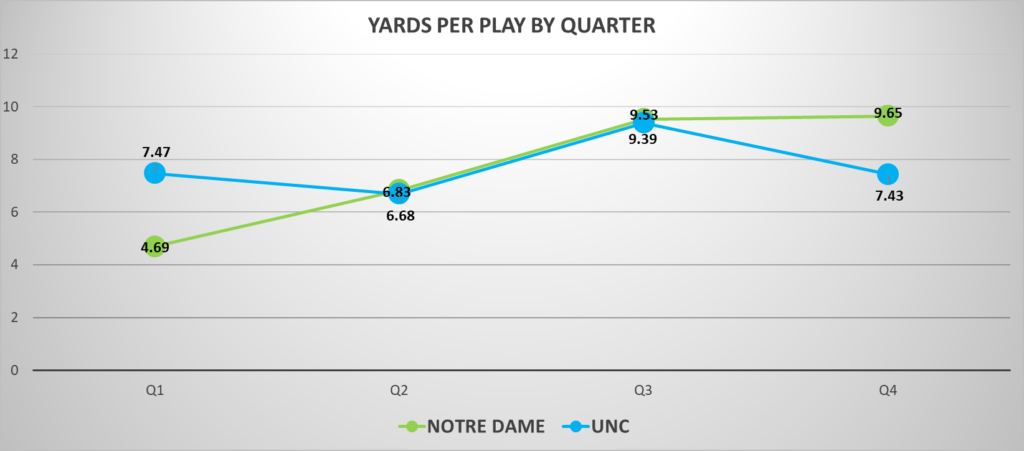
Confused? Check out this handy advanced stats glossary here or reach out in the comments.
The Irish keep finding edges in close games
For a second straight week, Notre Dame was able to scratch out a two-score win despite a very tightly contested battle in explosiveness and efficiency. The Irish had the yards per play advantage by the thinnest of margins (+0.06 yards/play), and Carolina similarly edged out ND in success rate (+2.7%). Both defenses struggled to make stops, with Notre Dame’s average drive gaining 53 yards and the Heels averaging 51. The Irish created 8 scoring chances in 10 possessions, Mack Brown’s team created 7 in 11.
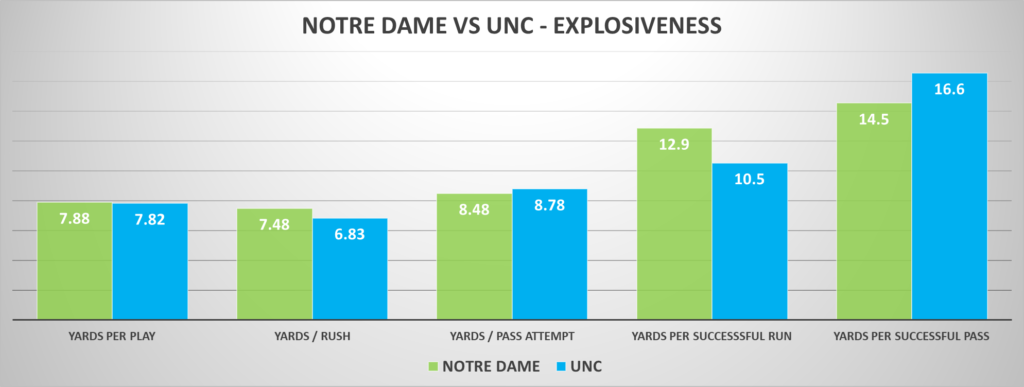
SP+ post-game win expectancy was again close (57% for the Irish), but what ultimately allowed the Irish to create their advantages? As with the USC game, turnovers, field position, penalties, and maximizing scoring chances decided the game. The Tar Heels had five more penalties for 35 yards than the Irish, and it could have been worse (thanks ACC refs). The average UNC drive started seven yards further back than the Irish. Both teams blew some special teams coverages, but ND added in the interception that gave the offense a possession beginning in the red zone.
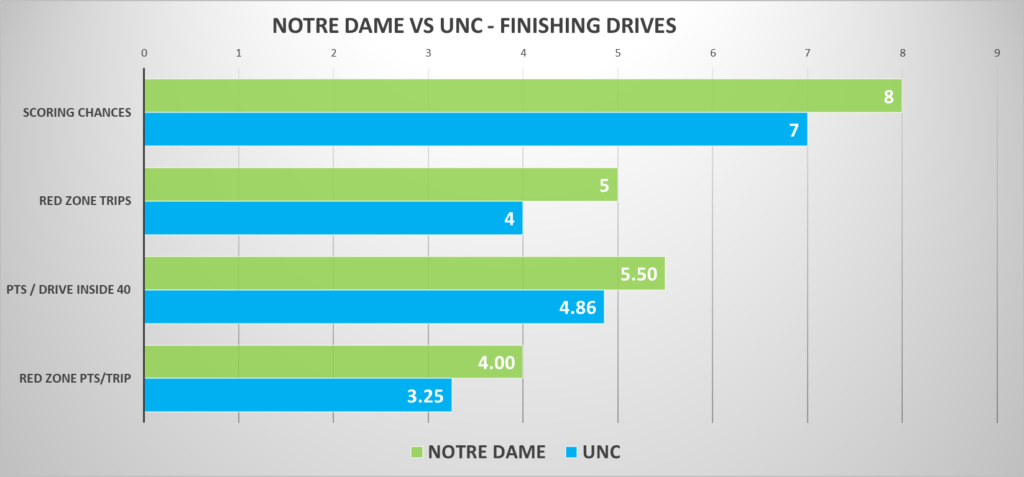
Notre Dame averaged more points per scoring opportunity and red zone trip than the Tar Heels, and that advantage has been a crucial ingredient to Irish wins all year. Despite the 7-1 record, Brian Kelly’s team has only created three more scoring chances than opponents this season, with 50 for the Irish and 47 for their foes. A big part of surviving relatively unscathed is the Irish averaging more points per scoring chance than their opponents in all eight games this season.

This lack of separation throughout the season across statistical categories – explosiveness, efficiency, scoring margin, scoring chances created – paint the picture of a team due for some regression. But there may not be a team left on the schedule capable of knocking off the Irish, and the 2022 team should benefit from health and returning young talent to build more significant advantages.
Marcus Freeman stock advice: hold
The defensive performance against the Heels was frustrating, even if the expectation was that a borderline top-10 offense with a great quarterback would move the ball well against an Irish secondary missing Kyle Hamilton. For the second time in three games, an opposing QB devastated the Irish defense with scrambles in critical situations. It’s an effort that was below expectations on paper but even worse to watch, with missed tackles galore and an uncharacteristic coverage bust.

It was a poor game, but not one deserving of Van Gorder references or throwing “bust” labels around, especially with Freeman’s track record. A preference for Clark Lea over Freeman is a far more reasonable take but might be overestimating the difference between this year’s defense and last year’s (with JOK, Daelin Hayes, Ade Ogundeji, Marist Liufau, and more veterans in the secondary).
So with a defense that’s less talented at linebacker and perhaps a touch thinner and less talented in the secondary, Freeman’s unit has performed similarly to last year’s playoff team. Yes, Alabama and Clemson obliterated last year’s defensive numbers in the final two games. Still, they also benefitted from some pretty hapless opponent attacks like USF (112th in Offensive F+), Duke (116th), Syracuse (123rd), and Pitt (94th) without future Heisman winner Kenny Pickett.
It’s easy to become a game-to-game prisoner of the moment and fondly remember Clark Lea’s peaks instead of game-to-game ebbs and flows. But also recall that Lea’s first year was a more seamless transition, carrying over the schematic foundation from one of his mentors in Mike Elko and with a talented and experienced roster that ranked 1st in FBS with 96% of its weighted defensive production returning. This year’s defense is rated similarly to 2020 in F+ (top 20), and it shouldn’t be earth-shattering for them to play at more like a top-40 level without their most talented and irreplaceable defender.
The disappearance of havoc is opening doors for the offense

The last few games have featured incredibly low rates of defensive disruption by both Notre Dame and its opponents. This pattern continued against North Carolina, with the quick passing offense avoiding sacks and the revamped offensive line showing steady progress, creating positive yardage on the ground and avoiding stuffs. The Irish have now allowed just four sacks in the past three games, quite the turnaround from allowing six in the home opener against Toledo.
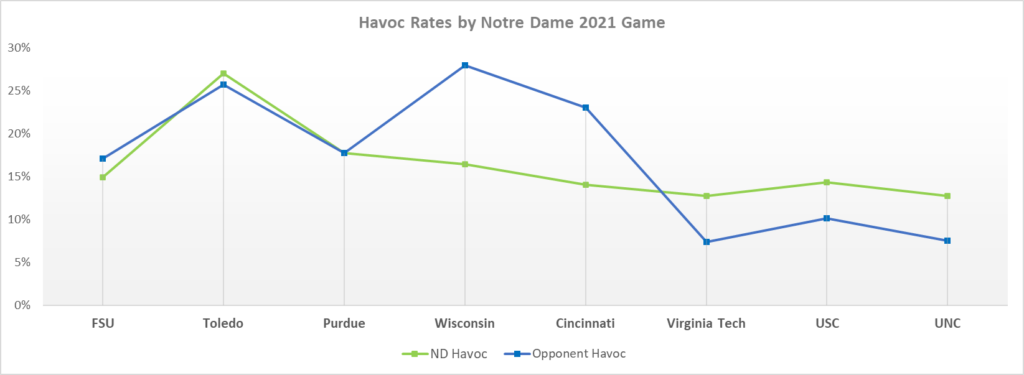
Keeping things moving more efficiently and avoiding negative plays has had a significant impact on the Irish offense. In Notre Dame’s first five games (through Cincinnati), they were able to create an extended (8+ play) drive on less than one in five offensive possessions (18%). Drastically reducing defensive disruption has allowed them to boost that long drive rate up to one in three drives (33%) going at least eight plays over the last three games.
A reminder that nothing is static in college football
Notre Dame’s 2021 season is a great reminder of the constantly evolving nature of the college game. Defining features of this team have swung wildly through portions of the season. We knew this team would never be able to run the ball behind this offensive line with Jack Coan at QB until after the bye week when things suddenly shook loose. The defense was excellent on 3rd down then struggled to get off the field in Blacksburg. The offense was dependent on big plays early on but now has evolved into a quick-hitting, more efficient attack.
The unpredictability is part of the fun as teams adjust, players gain experience and things click or sometimes they get hurt or lose confidence. Some games are defined by either randomly great or terrible matchups. Schematic adjustments can unlock new things or continue to flounder. Teams can and will inevitably change, which is why applying the transitive property for team or offensive/defensive performance is such a flawed idea.
A top-15 team again? In this rebuilding environment?
Notre Dame now ranks exactly the same in offensive and defensive F+, 18th in both, which adds up to 12th overall. The initial playoff rankings pegged the Irish 10th, and the Massey composite computer rankings have them 8th.
For a minute, can we consider just how insane this is? The offensive line was a complete mess through the first third of the season and has resurrected itself by inserting the 4th string, true freshman left tackle, and a redshirt sophomore who started the season listed as the backup center and unlikely to play significant snaps. At times it’s looked incredibly dark at quarterback, filled with sacks and glimmers of hope from another true freshman who then also has thrown extremely costly picks. The wide receiver and tight end rooms have been beaten up and thinned out to the point of not fielding an entire two-deep of scholarship players some weeks.
On defense, the linebackers have been similarly mauled by the injury bug. Kyle Hamilton missed almost all of the two games against the best passing attacks Notre Dame will face this season. They’ve flashed moments of brilliance but also surrendered mind-boggling two-minute scoring possessions and too easily let late leads evaporate. They’ve allowed five plays of 50+ yards but somehow managed to win all of the games where those long scores have taken place.
It’s been far from a perfect coaching season with the QB carousel and growing pains adjusting to Freeman (and vice versa). But Notre Dame’s ability to field this caliber of team, in what was already a rebuild or reload type of year before significant injuries, is unmistakably a win and testament to the state of the program. In a year of parity, it’s an accomplishment to field a top-15 caliber team. The talent and lack of experience of this team make it feel like one that should be celebrated for grinding out a 7-1 start instead of 4-3, as opposed to lamenting not being 8-0 and in the true playoff race.

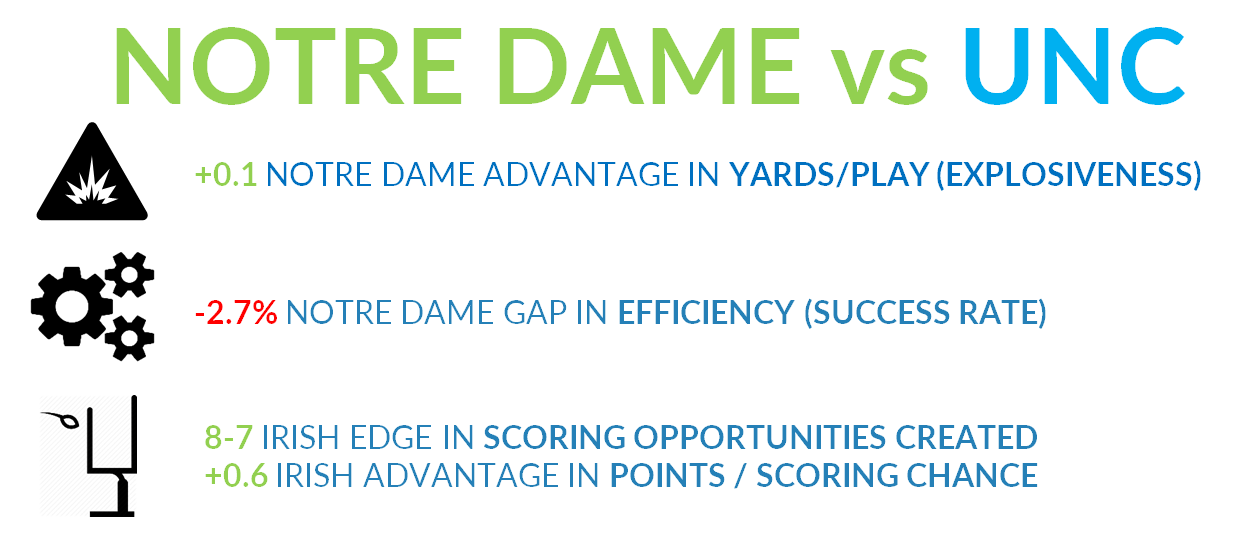



Thanks for providing the statistical perspective of all things Notre Dame!
To my untrained eye, it seems as though, after the first 2 or 3 games, Freeman toned down the aggressiveness slightly in an attempt to avoid the big plays that gashed the ND defense in those first few games. Is that what the smaller havoc rate in recent games is telling us?
Here’s another question — are the numbers consistent with the idea that Freeman’s defense has been far too generous to opponents at the end of the first half (allowing them to drive down the field quickly and score)?
Prevent in general isn’t effective. But in our case, I think it also exposes the largest weakness of the team, the secondary. So it’s double un-secret ineffective.
I think that’s definitely true w/r/t ND havoc and realizing what he had to do with the personnel on hand. Some is also matchup dependent, they still popped good havoc rates against a Wisconsin team that is a really good matchup (struggle to throw, few dangerous skill guys, wants to run) for this team and Cincy with an iffy O-Line.
For VT/USC/UNC I think it’s both scheme adjustments and matchups where havoc/aggression makes less sense. All of them to varying degrees want to spread you out and have dangerous skill guys, so getting run stuffs and pass break-ups is that much harder when you mostly are playing off and in zone, and don’t have a lot of guys in the box. There were some blown assignments in there but the general philosophy, especially without Kyle, to make them sustain drives and win red zone roulette with touchdowns seems like a god choice.
Hard to really tell in the data on the second question, it’s definitely a 4-game trend but comparing opponent YPP or points per possession versus other drives really isn’t apples to apples. The clock may stop a possession that may otherwise continue, and you may be ok in some scenarios allowing yards (i.e. a 12 yard run allowed on their own 20 with 30 seconds left is fine). But yes, the last four games allowing a Cincy TD, VT FG, USC should have been FG attempt thank you, and then UNC FG (lucky not worse) is bad times.
If we are looking at Freeman like an actual stock, I say now is the time to buy.
It’s the classic IPO story. Right after IPO (his hiring), the price sky-rocketed because everyone thinks this is the next big thing. Then leveled out as the initial excitement dies (games start being played). Now has dipped as people realize there’s no actual profits and settles where it should have been all along (the defense is not better than last years). So it’s time to buy as a long term investment based on the foundation that has been built (his recruiting and historical performance).
And it all pays off somewhere between 2 and 30 years down the road.
The last paragraph says so much. It feels like this team is operating at the absolute upper extreme of its potential, and everyone involved deserves a lot of credit for that. Smart, tough-as-nails players led by smart, tough-as-nails coaches. I get on the coordinators’ cases a lot but hauling this team to 7-1 in different way every week is an achievement. Many similar teams of years past would be going into November wondering if they could make the Beef O’ Bitcoin Bowl.
Let’s hope for a boring day against Navy.
Sign me up for a hearty serving of Beef O’ Bitcoin. Sounds expensively delicious.
I’m holding out for the Barnaby’s Beef Bar Bowl